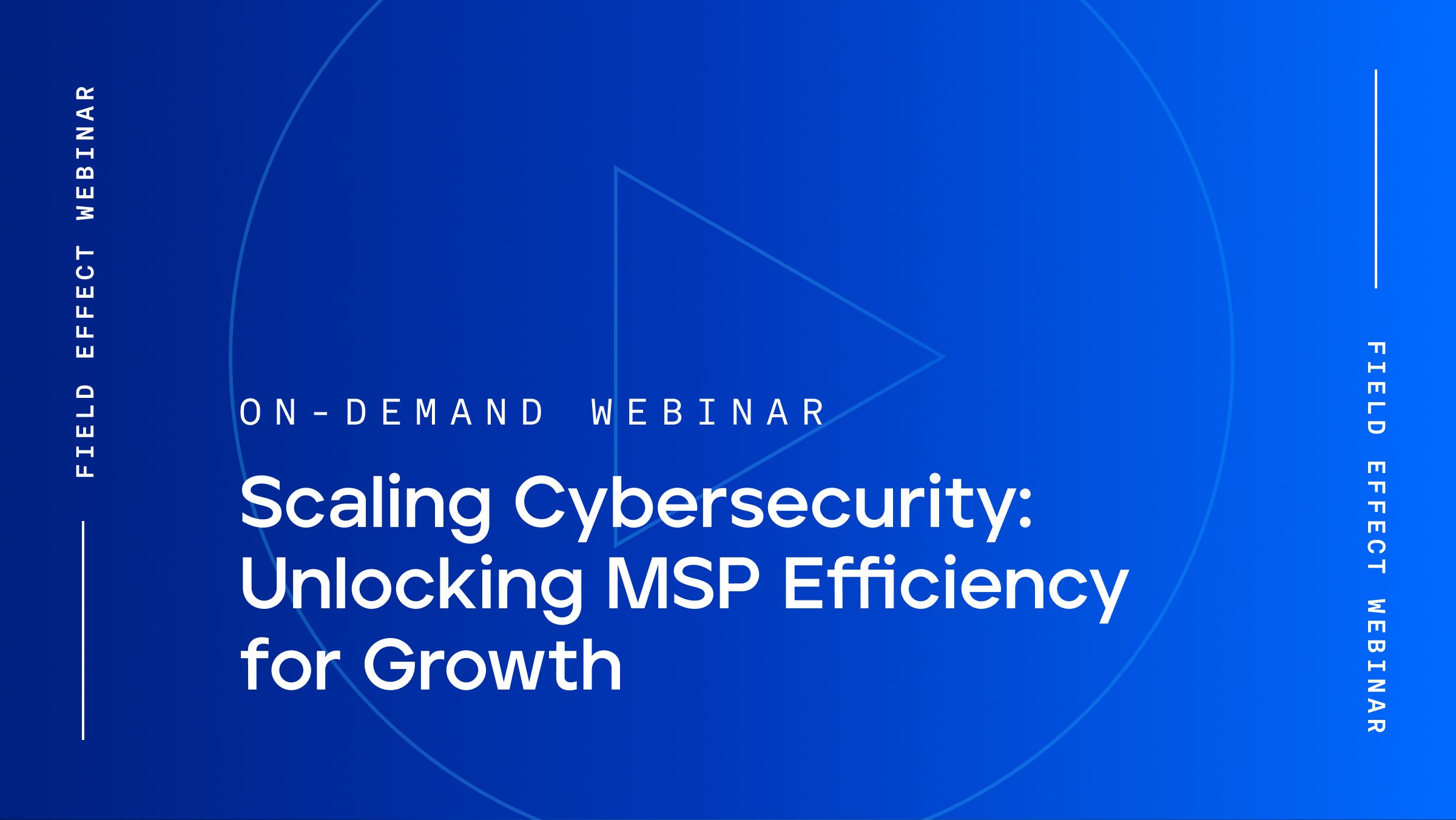
Blog Post
Last updated: January 19, 2024
Tool sprawl has become a top concern for many businesses, especially for managed service providers (MSPs) with a range of clients to support or services to deliver.
As the cybersecurity solutions market becomes increasingly crowded, MSPs are inundated with the "latest and greatest." The main problem is that every new tool added to your stack devours more budget and, if not well integrated, steals your team's time without returning much value.
If tool sprawl has started negatively affecting your ability to deliver a managed security service, consolidation may be the solution.
Consolidating tools to reduce sprawl can bring your business several critical benefits.
Tool sprawl often leads to inefficiencies. When you layer new and seemingly improved security tools on top of your existing ones, you may find yourself paying multiple providers for what's essentially the same technology. In other words, you're adding monthly or annual expenses without adding any real value.
Also, businesses often invest significant hours before the tool is even operating. First, it's the time spent sitting in demos or comparing reviews. Then you have to factor in hours for:
Collectively, these tasks can take a ton of time to complete, especially when multiplied across a large security tool arsenal. It can also make you feel like you need a larger team than you do, putting further strain on your budget.
Cybersecurity tool sprawl also leads to inefficiencies in administration. The more tools you use, the more dashboards you need to learn, check, update, and monitor over time. This can add up to a sizable amount of work for your employees.
Tool consolidation leads to less time spent on administrative tasks that add minimal value to your business. It can free your team up to spend more time strategizing, evaluating and capitalizing on new markets, creating better sales enablement or demo materials, and other tasks that bring real value back to your business.
Strong partnerships are integral to success. Vendor consolidation makes it easier to foster better connections with partners because you'll have more time to put toward aligning, strategizing, and collaborating with your vendors.
In fact, one report from Gartner found that rationalizing and/or consolidating vendors can decrease operational costs and risks, as well as "strengthen relationships, performance and business outcomes."
Inefficiencies arise when you stitch together narrow or limited tools to create a cohesive, comprehensive defense.
One reason is that cybersecurity vendors develop their tools differently, so when it comes time for integration, they fail to communicate. This lack of integration can quickly overwhelm your team and leave gaps in your clients' defenses.
When you use fewer tools, you'll face fewer issues when it comes time for integration.
It's natural to think investing in more cybersecurity tools will result in better security for your clients. But that's not necessarily true. Tool sprawl can negatively impact your ability to deliver the service in several ways.
Security alerts notify you when issues or vulnerabilities appear. For larger businesses, teams can receive thousands of these alerts every day. That can, naturally, make them feel less urgent and more like minor tasks on a to-do list.
Making matters worse, a lot of these alerts will be pure duplicates and lead to alert fatigue, a problem that today overwhelms 67% of security operations teams.
When you remove redundant tools that deliver duplicates, your team will have more time to investigate those that truly matter. Your team will feel confident that any alerts received are legitimate and critical.
There's also the issue of visibility to consider when evaluating whether your security tool sprawl has gone too far. When there are too many tools needing your team's attention, it often results in reduced visibility and, therefore, reduced protection.
For example, your team may only have time to read simplified monthly reports instead of doing more in-depth analyses that can boost a client's security posture to avoid future incidents.
All of these security issues can lead to delayed incident response times. When teams are overwhelmed by tools and a security incident happens, they'll inevitably be slower to respond due to information, alert, and dashboard overload.
The longer it takes your team to respond to a potential incident, the more time threat actors have to cause damage, steal data, and compromise your clients' systems. That's why optimizing your stack to detect and respond to threats quickly is so critical.
Tool sprawl can negatively impact your ability to carry out a superior managed security service, but it's never too late to reassess and improve your arsenal. If you're ready to fight back against tool sprawl, these tips will get you started.
The first step in tackling security tool sprawl is listing all the security tools you use to deliver a managed security service.
Consider the tools you use for various threat surfaces, such as the endpoint, cloud-based services, network, and email. Then, think about the threat lifecycle and the tools used for each stage, such as monitoring, detection, investigation, response, and recovery. Don't forget to include more proactive efforts, such as threat intelligence services or incident response preparedness.
Once you have your list, include the capabilities of each tool and vendor. Your goal is to create a comprehensive list of all of the different forms of security that you're currently paying for.
As you go through the inventory process, redundancies will arise. You may be footing the bill for two tools with the same security capabilities. Maybe you're paying one vendor for endpoint monitoring and another for network monitoring, while one can do both at an overall reduced rate. So this step is all about getting rid of blatant redundancies.
Consolidation isn't just a process of eliminating redundancies in your cybersecurity arsenal. It's also a time to consider whether the security capabilities you're paying for matter to your target audience.
For example, if you're an MSP serving primarily small businesses, you probably don't need to pay for security solutions designed for major enterprises. Larger businesses may have different security needs or compliance requirements than smaller ones.
You may also find you have tools that don't suit the industries you focus on. For example, protecting a manufacturing company with tons of operational technology may require different features or functionalities than if you were protecting remote financial firms.
That's why it's worth considering who your customers are and what security services they need as you go through your consolidation process.
Finally, re-evaluate your cybersecurity inventory and figure out how many point tools you're paying for. These tools are limited and often designed to execute one security task instead of covering broader parts of a business or company.
Point tools can eat up your security budget fast and represent a problem if you're trying to limit tool sprawl. Think about it—wouldn't you rather have one solution that protects the bulk of your client's threat surface than 50 tools securing only a tiny portion each?
If you're thinking about a holistic solution, it's a good idea to choose that first and build the rest of your security apparatus around it. Holistic cybersecurity platforms can accomplish many different security tasks, and you may only need one or two additional tools to meet all of your goals.
For example, a holistic cybersecurity solution can replace tools for:
With a holistic solution as the cornerstone of your security stack, you may only need a few other tools to meet client needs.
Tackling security tool sprawl is a worthwhile effort. But it's not free of challenges.
This is why it's crucial to choose a cybersecurity partner who truly cares about your onboarding experience and learning journey. The unfortunate reality is that vendors sometimes check out after the contract is signed.
The right partner will enable your marketing, sales, and delivery success with detailed training videos, webinars from cybersecurity experts, and ongoing support for your entire partnership, not just the first month or two.
Eliminating overlap and aligning your security offerings with your target market's needs can cut tool sprawl fast. But if you're looking for a single, simple solution to your problem, consider a holistic security solution such as Covalence.
Our partner program ensures MSPs have access to our all-in-one solution for protecting endpoints, cloud services, and networks, plus a team of cybersecurity experts available round-the-clock to help alleviate any staffing challenges.
Want to learn more? Book a free demo with us today, and we'll give you a personalized look at how we can help your company tackle security tool sprawl.


